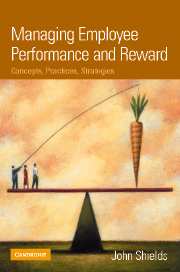Book contents
- Frontmatter
- Contents
- List of figures and tables
- Foreword by John Egan
- Acknowledgements
- Introduction: Setting the scene
- Part 1 The fundamentals
- Part 2 Performance management in action
- Part 3 Base pay and benefits
- Part 4 Rewarding employee performance
- 14 Overview of performance-related rewards
- 15 Merit pay for individual performance
- 16 Recognition awards
- 17 Results-based individual incentives
- 18 Collective short-term incentives
- 19 Collective long-term incentives
- 20 Executive incentives
- Case study. Beyond the hard sell: Performance incentives at Southbank
- Part 5 Fitting it all together
- Model responses to case studies
- References
- Index
17 - Results-based individual incentives
from Part 4 - Rewarding employee performance
- Frontmatter
- Contents
- List of figures and tables
- Foreword by John Egan
- Acknowledgements
- Introduction: Setting the scene
- Part 1 The fundamentals
- Part 2 Performance management in action
- Part 3 Base pay and benefits
- Part 4 Rewarding employee performance
- 14 Overview of performance-related rewards
- 15 Merit pay for individual performance
- 16 Recognition awards
- 17 Results-based individual incentives
- 18 Collective short-term incentives
- 19 Collective long-term incentives
- 20 Executive incentives
- Case study. Beyond the hard sell: Performance incentives at Southbank
- Part 5 Fitting it all together
- Model responses to case studies
- References
- Index
Summary
This chapter considers some of the oldest and most enduring (although not necessarily the most endearing!) of all performance pay plans, namely results-based individual incentives. Also known as individual ‘payment-by-results’ plans, these include piece rates, task-and-time bonus plans (where employees are rewarded for completing a specified volume of work or a task in less than a ‘standard’ time), sales commissions and bonus payments to individuals for achievement of goals. We consider each of these plans in turn, noting the advantages and drawbacks of each.
With such plans, the result–reward relationship can be either standardised (i.e. a single rate of reward per unit of output) or configured according to a sliding scale, as in the case of progressively scaled payments, whereby the rate of payment itself increases as output rises. Sometimes these systems are used in conjunction with a guaranteed minimum base pay; sometimes, as in the case of pure piecework and commission-only work, there is no guaranteed base pay at all. Piece rates and task-and-bonus plans were developed primarily for labour-intensive manufacturing jobs and had their heyday in the early to mid-twentieth century, when they were at the forefront of innovation in reward theory and practice in industrialised economies. However, interest in individual output-based incentives of this type has waned with the relative decline in manufacturing activity in Western economies since the 1970s. Sales commissions, of course, remain widely used in such sectors as retailing, finance, insurance and real estate.
- Type
- Chapter
- Information
- Managing Employee Performance and RewardConcepts, Practices, Strategies, pp. 399 - 412Publisher: Cambridge University PressPrint publication year: 2007



